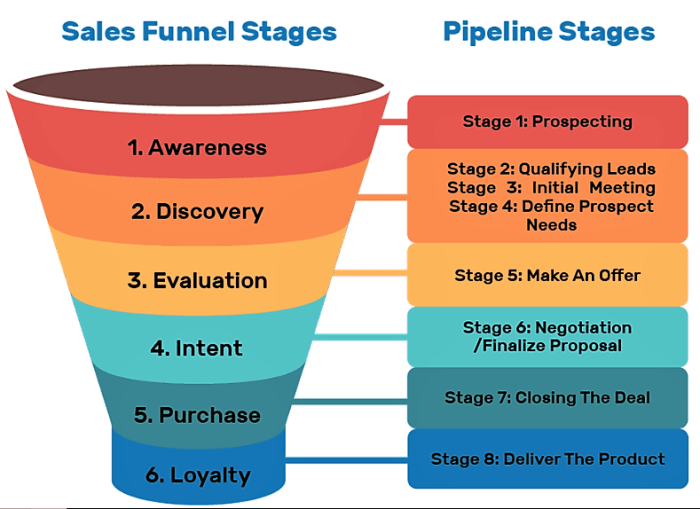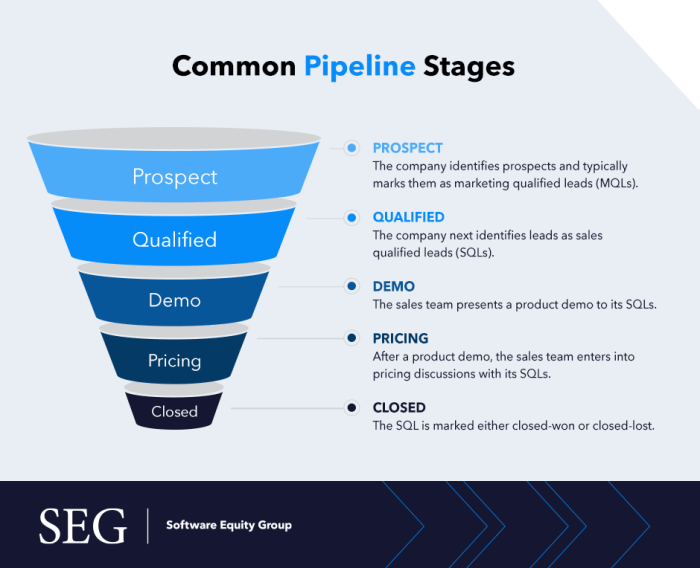Understanding the Sales Pipeline sets the stage for businesses to boost sales and make strategic moves like a boss. Get ready to dive into the world of sales pipelines where every stage is a potential game-changer.
In the realm of sales, the pipeline is not just a tool, but a roadmap to success. Let’s explore how mastering the sales pipeline can lead to increased revenue and streamlined processes.
Importance of Sales Pipeline: Understanding The Sales Pipeline

Understanding the sales pipeline is crucial for businesses as it provides a clear roadmap for the sales process, helping companies track and manage leads effectively.
Improved Sales Efficiency and Predictability
A well-defined sales pipeline can improve sales efficiency by streamlining the process from lead generation to closing the deal. By clearly defining each stage of the pipeline, sales teams can focus their efforts on progressing leads through the sales process, leading to higher conversion rates and increased sales predictability.
Role in Revenue Forecasting and Strategic Planning
The sales pipeline plays a significant role in revenue forecasting as it provides insights into the potential revenue that can be generated from current leads. By analyzing the sales pipeline, businesses can make more accurate revenue projections and adjust their strategies accordingly. Additionally, the sales pipeline is essential for strategic planning as it helps businesses identify areas for improvement, allocate resources effectively, and set realistic sales goals.
Components of a Sales Pipeline
In a typical sales pipeline, there are several key stages that play a crucial role in moving prospects through the sales process. Each stage contributes to the overall progression of leads towards becoming paying customers. It is essential to track progress at each stage to identify bottlenecks, optimize the sales process, and ultimately increase sales efficiency.
Lead Generation
Lead generation is the first stage of the sales pipeline, where potential customers are identified and attracted to the product or service offered. This stage involves activities such as marketing campaigns, social media outreach, and networking events. Generating high-quality leads is crucial for the success of the sales pipeline as it sets the foundation for further stages.
Qualification
Once leads are generated, the next stage is qualification, where the sales team evaluates the leads to determine their level of interest and fit for the product or service. Qualification helps in prioritizing leads and focusing efforts on prospects with a higher likelihood of conversion. It ensures that the sales team is targeting the right audience and not wasting time on unqualified leads.
Proposal
After qualifying leads, the sales team moves on to the proposal stage, where they present a tailored solution to the prospect based on their needs and pain points. The proposal Artikels the product or service offering, pricing, and terms of the deal. This stage is crucial as it demonstrates value to the prospect and serves as the final step before closing the deal.
Closing
The closing stage is where the final negotiations take place, and the prospect makes the decision to become a paying customer. This stage involves overcoming objections, addressing any concerns, and finalizing the terms of the agreement. Closing the deal is the ultimate goal of the sales pipeline, and successful closure leads to revenue generation for the business.
Overall, tracking progress at each stage of the sales pipeline is essential for identifying areas of improvement, optimizing the sales process, and maximizing sales efficiency. By monitoring the movement of prospects through the pipeline, businesses can make data-driven decisions, allocate resources effectively, and ultimately drive revenue growth.
Sales Pipeline Management

Effective sales pipeline management is crucial for the success of any sales team. By properly managing the pipeline, businesses can ensure a steady flow of leads and conversions, leading to increased revenue and growth.
Strategies for Effective Sales Pipeline Management
Implementing the following strategies can help streamline and optimize your sales pipeline:
- Regularly review and update your pipeline to ensure accuracy and relevance.
- Set clear goals and milestones for each stage of the pipeline to track progress.
- Provide ongoing training and support to your sales team to improve performance and efficiency.
- Utilize data analytics to identify trends and patterns in your pipeline for better decision-making.
Use of CRM Systems and Sales Tools
CRM systems and sales tools play a vital role in managing and monitoring the sales pipeline. These tools help in tracking customer interactions, forecasting sales, and automating repetitive tasks.
CRM systems allow businesses to centralize customer information, track communication history, and streamline the sales process.
Best Practices for Maintaining a Healthy Sales Pipeline, Understanding the Sales Pipeline
To maintain a healthy and efficient sales pipeline, consider the following best practices:
- Regularly communicate with leads to keep them engaged and interested in your product or service.
- Qualify leads effectively to focus on those with the highest potential for conversion.
- Monitor key performance indicators (KPIs) to track the effectiveness of your sales pipeline.
- Continuously optimize and refine your sales process based on feedback and data insights.
Sales Pipeline Metrics
When it comes to measuring sales pipeline performance, there are several key metrics that play a crucial role in evaluating the health and efficiency of the sales process. These metrics provide valuable insights that help sales teams identify bottlenecks, track progress, and make informed decisions to drive revenue growth.
Conversion Rates
Conversion rates refer to the percentage of leads or prospects that move from one stage of the sales pipeline to the next. By tracking conversion rates at each stage, sales teams can pinpoint where leads are dropping off and take necessary actions to improve conversion rates.
Velocity
Velocity measures the speed at which leads move through the sales pipeline. It helps sales teams understand the average time it takes for a lead to convert into a customer. By analyzing velocity, sales teams can identify delays and streamline the sales process for quicker conversions.
Win Rates
Win rates indicate the percentage of deals won compared to the total number of deals pursued. Monitoring win rates helps sales teams understand their success rate and the effectiveness of their sales strategies. By improving win rates, sales teams can increase revenue and achieve their sales targets.
Overall, these metrics provide valuable data-driven insights that enable sales teams to identify areas for improvement, optimize their sales process, and make strategic decisions to drive revenue growth. By leveraging these metrics effectively, sales teams can enhance their performance, boost efficiency, and achieve their sales goals.












